This authentic Cacio e Pepe recipe requires only 20 minutes and 6 ingredients to make creamy, dreamy pasta WITHOUT any cream!
Cacio e Pepe literally means “cheese and pepper,” and this minimalist pasta couldn’t be any easier or more delicious! It’s an Italian favorite originating in Rome that requires technical prowess – but don’t worry, I’ve sorted, tested and experimented with various methods to bring you WHAT WORKS for the creamiest Cacio e Pepe recipe every time. To make Cacio e Pepe, Pecorino Romano is mixed with pasta water, butter and freshly cracked pepper to create a luxuriously emulsified creamy pepper sauce that’s out of this world. Twirl in your pasta and you have dinner on the table in minutes. Cacio Pepe is the ultimate quick and easy dinner the whole family will LOVE, crave and beg for again and again!

PIN THIS RECIPE TO SAVE FOR LATER
What is Cacio e pepe?
Before Patrick and I toured Italy this past fall (see my IG highlights), I wasn’t familiar with Cacio e Pepe, and now I am obsessed! It was on every restaurant menu in Rome because it is pure addicting, creamy, tangy, slurp worthy comfort food (and perfect for upcoming Valentine’s Day!). I promise you will crave it like crazy – I’m sorry and you’re welcome.
Cacio e pepe (pronounced [kaˈtʃo e ˈpeːpe]) is a pasta dish from modern Roman cuisine that literally translates into “cheese and pepper.” Cacio e Pepe first appeared on the Roman cooking frontier in the mid-twentieth century and now is a staple in Rome and throughout Italy. True to its name, Cacio e Pepe is often referred to as the stripped-down mac and cheese of Italy. It exemplifies the use of simple, quality ingredients (cheese, butter, olive oil, salt and pasta) in perfect proportions and pan sauce precision to create something extraordinary.
Cacio is the local Roman dialect for Pecorino Romano, a sheep’s-milk cheese made in the region and essential to Cacio Pepe. To make Cacio e Pepe, the pasta gets simmered in small amount of water to make the water extra starchy (so it can become creamy) and then part of the water is added to sautéed butter, olive oil and pepper. Pecorino Romano is then mixed into the buttery bath to create a lusciously creamy, buttery cheese sauce that envelops the pasta in its velvety peppery glory.
What sets the Cacio e Pepe Recipe apart:
There are millions of Cacio e Pepe recipes out there, but Cacio e Pepe is more than just combing ingredients together. It comes down to the quality of ingredients and technique. Here’s what set’s this Cacio e Pepe recipe apart:
- Starchy water: the pasta is cooked in a minimal amount of water and the reserved pasta water is only removed at the very end of cooking for maximum starchiness. This results in water that beautifully emulsifies with the cheese and butter to create the extra creamy, rich sauce.
- The cheese: many recipes call for Pecorino Romano OR Parmesan but authentic Cacio e Pepe is always made with Pecorino Romano (it is literally in the name!) because it is 3X more flavorful!
- Flavor. In addition to using Pecorino Romano, this Cacio e Pepe boasts buttery, toasted pepper through and through. The pepper is toasted in butter to bloom the flavor and then the reserved pasta water and cheese are added which evenly distributes the flavor throughout the entire sauce rather than sprinkling the pepper on top at the end.
- Technique. Quick and easy aren’t necessarily the same thing. You can’t just boil and strain pasta, dump a bunch of grated cheese on it and stir in black pepper or you will end up with a clumpy mess with unremarkable flavor. In this Cacio e Pepe recipe, I’ve detailed the most successful way achieve a gloriously silky, cohesive, lump free sauce every time. When you follow my technique, quick and easy can mean the same thing.

What you’ll need for Cacio e Pepe Pasta
If you have been following me for long, you know I will not hesitate to add an ingredient if I think it will improve a dish, but Cacio e Pepe is one case in which less, truly is more. Cacio e Pepe is made with just a few ingredients that magically transform into deep, rich, salty, satisfying splendor. That being said, it is important to use quality ingredients. You will need:
- Pasta: Tonnarelli is the traditional pasta for Cacio de Pepe but you may use easier to find spaghetti or bucatini. I do not suggest linguine and definitely not angel hair as they do not have enough bite (more details to follow).
- Pecorino Romano cheese. Quality, aged Pecorino Romano is quintessential to Cacio e Pepe. Please do not use Parmesan as it is not nearly as flavorful (see below)! Pecorino Romano can be found with the specialty cheeses at your grocery store. You will need 3 oz. which equals 1 ½ cups.
- Pepper: Use freshly cracked black pepper, it tastes far superior to ground pepper and will elevate your entire dish. I go for about 50 grinds of pepper, but you can use more or less to taste – but remember, you are supposed to taste the heat of the pepper.
- Olive Oil: use extra-virgin olive oil for the best flavor. The higher quality the oil, the more flavor.
- Butter: some recipes use butter, some don’t but I highly recommend using butter verses all olive oil. It adds tons of flavor.
- Salt: good old’ table salt is used to flavor the pasta water. Don’t skip or you’ll be skipping out on tons of free flavor and our only chance to flavor the pasta itself.
Can you use Parmesan for cacio e pepe?
I’ve seen many Cacio e Pepe recipes call for Pecorino Romano OR Parmesan, but this is not accurate. Cacio e Pepe is literally named after Pecorino Romano (remember “Cacio” is the local Roman dialect for Pecorino Romano) and not Parmesan – they should not be used interchangeably. Cacio e Pepe made with Pecorino Romano results in superior flavor and silkiness AKA far superior pasta.
While both cheeses are aged, salty hard cheeses, Pecorino is WAY more flavorful. Pecorino Romano, made from sheep’s milk, is sharper, salter, tangier, more pungent and assertive. Parmesan, made from cow’s milk, is a bit more neutral and milder overall. In fact, Cooks Illustrated suggests using one-third less Pecorino than Parmesan in recipe substitutions –that essentially means Pecorino Romano is 3x more flavorful!
All that being said, if you only have Parmesan on hand and want to make this Cacio e Pepe – you may use Parmesan, but just be aware it will not taste as intoxicating as intended – next time splurge for the real thing!
What Pasta is best for Cacio e Pepe?
Cacio e Pepe requires a long, smooth noodle that can be easily swaddled in the sauce but is “toothy” enough, meaning it is hearty and thick enough to stand up against the peppery sauce. You don’t want a noodle like angel hair that will just melt away. Here are the most popular pastas for Cacio e Pepe:
- Tonnarelli: as previously mentioned, Tonnarelli is the traditional pasta for Cacio de Pepe, so if you can get your hands on it, it is fabulous. Tonnarelli is a variety of egg pasta from Lazio, Italy, with a square cross section about 2–3 mm thick. Tonnarelli is so toothsome it nearly bites back.
- Bucatini: is the next best thing to tonnarelli. It looks like spaghetti but is slightly thicker and chewier with a hole going through the middle which is delightful because it gets filled with sauce.
- Spaghetti alla chitarra: also known as maccheroni alla chitarra, is a variety of egg pasta typical of Abruzzo, Italy, with a square cross section about 2–3 mm thick.
- Ciriole: is the thicker version of chitarra, approximately double the thickness of spaghetti.
- Spaghetti: is what I usually serve with Cacio e Pepe because it is easy to find and works beautifully.

How to Make Cacio e Pepe
To make Cacio e Pepe, pasta is tossed with an emulsified, luxuriously creamy, pepper sauce made with Pecorino Romano, black pepper and butter bound by starchy pasta cooking water.
If you were to watch an expert make Cacio e Pepe, you might be left with the illusion that it’s as simple as combining all of the ingredients together one after the other. Cacio e Pepe, however, is more than tossing pasta with butter and cheese. If that’s all you do, you will be left with a greasy, clumpy mess with cheese that refuses to melt. With Cacio e Pepe, a recipe with just a few ingredients, technique is everything. Here’s how to make it perfectly every time:
- Cook pasta. Add 2 quarts water (8 cups) to a Dutch oven (or stockpot wide enough to fit spaghetti). The water will be very shallow because we want it to be very starchy. Cover and bring to a boil. Uncover and stir in salt then add spaghetti. Cook pasta just until barely al dente (usually a couple minutes less than the package directions) stirring often so the spaghetti doesn’t stick. Don’t overcook pasta because it will cook some more when combined with the sauce.

- Begin making sauce. While the pasta is cooking, melt butter with olive oil in a large skillet over medium heat. While the butter is melting, add freshly cracked pepper, then continue to cook for one minute in order to “bloom” the pepper and deepen the flavor. Remove from heat and set aside until pasta is done cooking.

- Reserve pasta water. Reserve 1 ¼ cups pasta water before you drain the pasta. The water will be shallow, so carefully tilt the pot to one side to fill your measuring cup. Drain the pasta in a colander and set aside.
- Add pasta water and rest. Slowly whisk in 1 cup reserved pasta water into the butter off heat. Be careful as it will bubble up a bit. The pasta water will make the sauce smooth and glossy as it emulsifies with the butter and cheese. Once combined, let the butter/water stand 3 minutes. This resting time ensures the sauce isn’t too hot to receive the cheese which can cause it to seize.
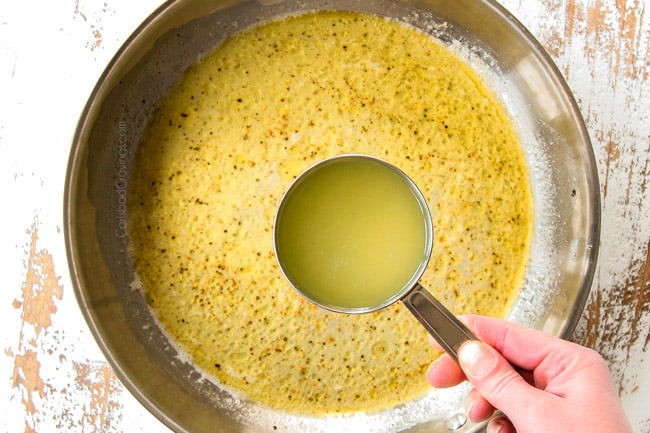
- Add cheese. Gradually whisk cheese into butter water a little at a time until combined. Turn heat to LOW and whisk constantly until cheese is completely melted and smooth. Whisking the cheese until melted will result in glossy, luscious sauce every time.

- Add pasta. Add half of the pasta to the skillet and stir to coat. Add remaining pasta and toss until evenly combined, adding additional pasta water if needed to loosen pasta.

- Serve. Serve warm and garnish with additional pepper and freshly grated Pecorino Romano to taste.

How to avoid clumping in Cacio e Pepe Sauce
There are several factors that help prevent cheese from clumping in Cacio e Pepe. If you follow these helpful tips, you’ll achieve silky sauce every time:
- Use high quality ingredients. High quality ingredients are essential in this dish, most importantly Pecorino Romano. Use the best imported Pecorino Romano that you can afford.
- Grate cheese yourself. Freshly-grated Pecorino Romano is a MUST in this Cacio e Pepe recipe. If you use pre-grated cheese, your sauce will by clumpy. Pre-packaged cheeses are coated with anti-clumping chemicals which inhibit them from melting beautifully.
- Grate cheese first. The freshly grated cheese needs to be added to the hot water/butter mixture minutes after the water is added – there is no time to stop and grate your cheese, so take care to grate your cheese before you begin cooking. You can grate the cheese while the pasta water is coming to a boil but that’s as close as I’d cut it.
- Use finely grated cheese. Grate your cheese on the finest holes of your cheese grater, the small, prickly side of the box grater. We want to produce powdery Pecorino Romano that looks like what comes in the store-bought containers with the green lid. Cheese that’s grated on larger holes will clump because it takes the cheese longer to melt and the larger amount of surface area allows for more clinging potential.
- Do NOT adjust the amount of water for cooking the pasta. The concentrated starchy pasta water is critical to the success of this Cacio e Pepe recipe. Do NOT increase the amount of water or it will become less starchy.
- Don’t reserve pasta water early. The pasta water will become increasingly starchy as it cooks with the pasta so it is critical to not reserve the water before the pasta is done cooking and releasing starch.
- Let pasta water cool. Allowing the pasta water to cool for 3 minutes before adding it to the butter prevents it from being too hot when the cheese is added which can cause the cheese to seize. Instead, resting the water and then gradually melting the cheese over low heat provides a seamless, gradual melting process.
- Don’t add cheese all at once. Slowly whisking the cheese into the sauce a little at a time will help the cheese melt more evenly because it has more liquid to surround it instead of being slammed against surrounding cheese.
- Don’t confuse cheese not melting with clumping. Your cheese will not magically, instantaneously melt into glossy seduction as soon as it hits the butter/water which is perfectly okay – it will not stay this way. The cheese will gradually melt as you whisk constantly over low heat.
- Continue to whisk until cheese is melted. Your cheese might take more or less than 5 minutes to melt depending on the actual heat of the sauce, quality of cheese and size of pan. The important thing is to continue to whisk until the cheese has melted – as long or as little time as required.

The Best Cacio e Pepe Recipe tips for success
- Salt water. Salting the pasta water infuses the pasta and the water with flavor which translates to more flavorful Cacio e Pepe.
- Stir pasta frequently while it cooks. Because we are cooking the pasta in less water than normal, make sure to stir the pasta frequently while cooking so that it doesn’t stick to the pot, this includes multi-tasking while you melt the butter and sauté the pepper.
- Don’t overcook pasta. Just like clumpy cheese can ruin Cacio e Pepe, so can mushy pasta. Make sure to cook your pasta just until barley al dente, meaning it has a bite, this is usually a couple minutes before the box says – so set your timer accordingly. You want to avoid over-cooking the pasta because it will continue to cook a little when combined with the sauce.
- How do you know when pasta is done? The only way to know when your pasta is done is to taste it! I remove a strand of pasta with a slotted spoon, rinse it in cool water and then taste. Don’t be tempted to bite into pasta straight from the boiling pot-you will burn your tongue!
- Use a large enough pan. Use a pan that is large enough to eventually hold all of the ingredients, including the pasta, with wiggle room to comfortable twirl and toss without whipping sauce everywhere.
- Use freshly cracked pepper. Please do NOT use pre-ground pepper. Unlike pre-ground pepper, freshly coarsely ground pepper has not been oxidized, or exposed to oxygen, which means it has a richer flavor and tastes worlds better than ground pepper. Its coarse texture also adds the peppery heat we love in Cacio e Pepe.
- Toast pepper first, don’t add after. The pepper should be added directly to the butter and olive oil. Toasting the pepper infuses the sauce with even pepper flavor whereas adding pepper after will not result in as deep of flavor and it will seem like an unevenly distributed after thought as opposed to being one with the sauce.
- Thin sauce if needed. If the pasta seems dry after it is combined with the sauce, stir in additional pasta water just a little at a time.
- Thicken sauce if needed. If the sauce is still too wet/runny after you add the pasta, gently simmer just until it has reduced enough to cling to the pasta.
- Let the pasta rest before serving. Letting the dish rest briefly before serving allows he flavors to develop and the sauce to thicken.

Spaghetti Cacio e Pepe Variations
Cacio e Pepe is mesmerizing in its simplicity. We like to serve it as is with veggies and protein on the side, but it also can be used as a springboard for other variations. Feel free to customize this recipe with all sorts of add-ins – just don’t call it Cacio e Pepe or you will be thrown out of town – or at least Rome.
- Garlic: sauté 2-4 minced garlic cloves in the butter with the black pepper.
- Crushed red pepper flakes: sauté a pinch of red pepper flakes in the butter with the black pepper.
- Seasonings: you can add any seasoning such as Italian seasoning, dried basil, thyme, oregano, etc. but I think you’ll find Cacio e Pepper is minimalistic for a reason – the simplicity allows the outrageously flavorful cheese to shine.
- Flavorings: add a splash of lemon juice or pesto.
- Sun-dried tomatoes: replace the olive oil with oil from the sun-dried tomato jar and sauté chopped sun-dried tomatoes in the butter with the black pepper.
- Fresh or fire roasted diced tomatoes: you can sauté chopped fresh Roma tomatoes in the butter with the black pepper or stir in fire roasted diced tomatoes at the end of cooking and heat through.
- Vegetables: You can add any chopped vegetables such as zucchini, bell peppers, mushrooms, asparagus, green beans, etc. and sauté them in in the butter and olive oil until crisp tender or stir in frozen defrosted petite peas at the end of cooking. You can also add roasted vegetables directly to the pasta at the end of cooking. Adding volume in vegetables means you might want to increase the amount of sauce so it’s not spread too thin. This simply means increasing the amount of pasta water and cheese.
- Greens: Stir in spinach or kale directly into the pasta to wilt.
- Protein: You can stir in any cooked protein at the end of cooking. Bacon, Italian sausage, sautéed shrimp and buttery salmon pair particularly well.
What to serve with Spaghetti Cacio e Pepe
Cacio e Pepe makes a fantastic meatless entrée or you can serve it as a side. Regardless, we always love it with salad and bread. Here are some more fun and flirty ideas:
- Protein: If you’re serving Cacio e Pepe as a side, it pairs well with Baked Salmon in Lemon Garlic Sauce (one of my favs!), Garlic Butter Pork Tenderloin, Lemon Pepper Chicken, Pesto Chicken, Caprese Chicken, Shrimp Scampi and Spice Rubbed Steaks
- Bread: Garlic Bread is a personal favorite of mine with Cacio e Pepe – or just plain (it’s just SO good!), but it’s also delish with Dinner Rolls, or Garlic Parmesan Butter Breadsticks.
- Salad: This creamy Cacio e Pepe pairs beautifully with a fresh, crunchy salad such as Wedge Salad with Blue Cheese Ranch, Cucumber Tomato Salad, Strawberry Salad with Balsamic Vinaigrette, Apple Salad, Pear Salad, Roasted Butternut Squash Salad or Green Bean Salad.
- Vegetables: You can serve vegetables alongside your salad or skip the salad altogether. I like to roast vegetables when making Cacio e Pepe because they can be caramelizing all on their own in the oven while I pay attention to the stove. Some of my favorites include: Roasted Parmesan Broccoli, Roasted Parmesan Asparagus, Roasted Butternut Squash, Roasted Carrots, Roasted Cauliflower and Roasted Butternut Squash.
- Fruit: Bright, fresh fruit is always a welcome side with pasta. Go as simple as grapes, melon, etc. or you’ll love Fruit Salad with Honey Lime Vinaigrette, Winter Fruit Salad with Honey Lime Poppy Seed Vinaigrette and Berry Salad in Honey Mascarpone, Tropical Fruit Salad, or Pina Colada Fruit Salad.

Storing leftover Cacio e Pepe Pasta
This Cacio e Pepe recipe does not make a lot, so you won’t likely have leftovers, but in the rare and happy chance that you do, it stores beautifully. Store leftovers in an airtight container in the refrigerator for up to five days.
Reheating Spaghetti Cacio e Pepe
This Cacio e Pepe recipe reheats well in the microwave or on the stovetop, just make sure you cook your pasta al dente.
- Microwave: Add a splash of water to your individual serving; no need to stir it in, yet. Microwave for one minute, stir, then continue to heat at 30 second intervals until warmed through.
- Stove: For larger portions, reheat pasta on the stove. You will need to add a splash of water to thin the sauce as it will have thickened in the refrigerator.
LOOKING FOR MORE ITALIAN RECIPE Favorites?
- Manicotti with homemade Marinara
- Bolognese
- Rigatoni in Tomato Cream Sauce
- Lasagna and Lasagna Soup
- White Chicken Lasagna and White Chicken Lasagna Soup
- Minestrone Soup
- Lemon Garlic Shrimp Fettuccine
- Weeknight Spaghetti Bolognese
- Italian Spaghetti and Meatballs

Want to try this Cacio e Pepe RECIPE?
Pin it to your PASTA, DINNER or 30 MINUTE MEALS Board to SAVE for later!
Find me on Pinterest for more great recipes! I am always pinning :)!
©Carlsbad Cravings by CarlsbadCravings.com
Tools Used in This Recipe
See Favorite Tools
BEST Cacio e Pepe Recipe
Save This Recipe To Your Recipe Box
You can now create an account on our site and save your favorite recipes all in one place!
Ingredients
- 8 ounces spaghetti may sub bucatini
- 1 teaspoon salt (for pasta water)
- 3 tablespoons unsalted butter
- 1 tablespoon extra virgin olive oil
- 50 turns freshly-cracked coarse black pepper (1 teaspoon)
- 1 1/2 cups finely freshly-grated Pecorino Romano NOT Parmesan
Instructions
- Add 2 quarts water (8 cups) to a Dutch oven (or stockpot wide enough to fit spaghetti). The water will be very shallow because we want it to be very starchy. Cover and bring to a boil. Uncover and stir in salt then add spaghetti. Cook pasta until barely al dente (usually a few minutes less than package directions), stirring often so the spaghetti doesn’t stick. See next step to complete while pasta is cooking.
- While the pasta is cooking, melt butter with olive oil in a large skillet over medium heat. Add pepper, then cook for one minute. Set aside until pasta is done cooking.
- Once pasta is al dente, reserve 1 ¼ cups pasta water, then drain pasta in a colander and set aside.
- Slowly whisk in 1 cup reserved pasta water into the butter off heat. Let stand 3 minutes.
- Gradually whisk cheese into butter water a little at a time until combined. Turn heat to LOW and whisk constantly until cheese is completely melted and smooth.
- Add half of the pasta to the skillet and stir to coat. Add remaining pasta and toss until evenly combined, adding additional pasta water if needed to loosen pasta.
- Taste, and season with extra salt and pepper if desired. Serve warm.
Notes
Tips to Master Cacio e Pepe
Cacio e Pepper is easy WHEN you follow these tips and tricks:- Use Pecorino Romano cheese. Quality, aged Pecorino Romano is quintessential to Cacio e Pepe and results in superior flavor and silkiness AKA far superior pasta. Cacio e Pepe is literally named after Pecorino Romano (“Cacio” is the local Roman dialect for Pecorino Romano and not Parmesan) – they should not be used interchangeably. In fact, Pecorino Romano is 3X as flavorful as Parmesan! Pecorino Romano can be found with the specialty cheeses at your grocery store. Use the best imported Pecorino Romano that you can afford. You will need 3 oz. which equals 1 ½ cups.
- Grate cheese yourself. Freshly-grated Pecorino Romano is a MUST in this Cacio e Pepe recipe. If you use pre-grated cheese, your sauce will by clumpy. Pre-packaged cheeses are coated with anti-clumping chemicals which inhibit them from melting beautifully.
- Grate cheese first. The freshly grated cheese needs to be added to the hot water/butter mixture minutes after the water is added – there is no time to stop and grate your cheese, so take care to grate your cheese before you begin cooking. You can grate the cheese while the pasta water is coming to a boil but that’s as close as I’d cut it.
- Use finely grated cheese. Grate your cheese on the finest holes of your cheese grater, the small, prickly side of the box grater. We want to produce powdery Pecorino Romano that looks like what comes in the store-bought containers with the green lid. Cheese that’s grated on larger holes will clump because it takes the cheese longer to melt and the larger amount of surface area allows for more clinging potential.
- Do NOT adjust the amount of water for cooking the pasta. The extra starchy pasta water is critical to the success of this Cacio e Pepe recipe. Do NOT increase the amount of water or it will become less starchy.
- Don’t reserve pasta water early. The pasta water will become increasingly starchy as it cooks with the pasta so it is critical to not reserve the water before the pasta is done cooking and releasing starch.
- Salt water. Salting the pasta water infuses the pasta and the water with flavor which translates to more flavorful Cacio e Pepe.
- Stir pasta frequently while it cooks. Because we are cooking the pasta in less water than normal, make sure to stir the pasta frequently while cooking so that it doesn’t stick to the pot, this includes multi-tasking while you melt the butter and sauté the pepper.
- Don’t overcook pasta. Just like clumpy cheese can ruin Cacio e Pepe, so can mushy pasta. Make sure to cook your pasta just until barley al dente, meaning it has a bite, this is usually a couple minutes before the box says – so set your timer accordingly. You want to avoid over-cooking the pasta because it will continue to cook a little when combined with the sauce.
- How do you know when pasta is done? The only way to know when your pasta is done is to taste it! I remove a strand of pasta with a slotted spoon, rinse it in cool water and then taste. Don’t be tempted to bite into pasta straight from the boiling pot-you will burn your tongue!
- Let pasta water cool. Allowing the pasta water to cool for 3 minutes before adding it to the butter prevents it from being too hot when the cheese is added which can cause the cheese to seize. Instead, resting the water and then gradually melting the cheese over low heat provides a seamless, gradual melting process.
- Use a large enough pan. Use a pan that is large enough to eventually hold all of the ingredients, including the pasta, with wiggle room to comfortable twirl and toss without whipping sauce everywhere.
- Use freshly cracked pepper. Please do NOT use pre-ground pepper. Unlike pre-ground pepper, freshly coarsely ground pepper has not been oxidized, or exposed to oxygen, which means it has a richer flavor and tastes worlds better than ground pepper. Its coarse texture also adds the peppery heat we love in Cacio e Pepe.
- Toast pepper first, don’t add after. The pepper should be added directly to the butter and olive oil. Toasting the pepper infuses the sauce with even pepper flavor whereas adding pepper after will not result in as deep of flavor and it will seem like an unevenly distributed after thought as opposed to being one with the sauce.
- Don’t add cheese all at once. Slowly whisking the cheese into the sauce a little at a time will help the cheese melt more evenly because it has more liquid to surround it instead of being slammed against surrounding cheese.
- Don’t confuse cheese not melting with clumping. Your cheese will not magically, instantaneously melt into glossy seduction as soon as it hits the butter/water which is perfectly okay – it will not stay this way. The cheese will gradually melt as you whisk constantly over low heat.
- Continue to whisk until cheese is melted. Your cheese might take more or less than 5 minutes to melt depending on the actual heat of the sauce, quality of cheese and size of pan. The important thing is to continue to whisk until the cheese has melted – as long or as little time as required.
- Thin sauce if needed. If the pasta seems dry after it is combined with the sauce, stir in additional pasta water just a little at a time.
- Thicken sauce if needed. If the sauce is still too wet/runny after you add the pasta, gently simmer just until it has reduced enough to cling to the pasta.
- Let the pasta rest before serving. Letting the dish rest briefly before serving allows he flavors to develop and the sauce to thicken.

Did You Make This Recipe?
Tag @CarlsbadCravings and Use #CarlsbadCravngs
Leave a Review, I Always Love Hearing From You!
Carlsbad Cravings© Original
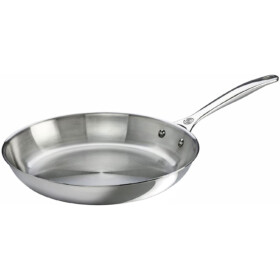
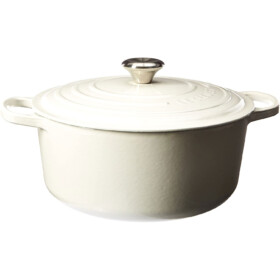











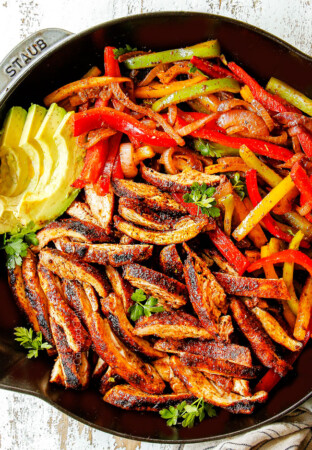

















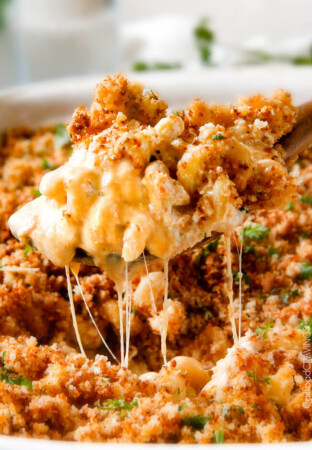


Kaci says
So, so, so good!
Jen says
Thank you Kaci!
Gary Mooney says
I commented previously on how good this recipe and instructions are, but I was using parmigiana regianno. I finally found pecorino romano and used it. But this cheese clumps up, either when adding to the sauce if it is too warm (first time I tried it) or when combining it with the warm pasta (second time). This isn’t the case with the parmigiana, so I’m inclined to use it in future.
Jen says
Thanks for the heads up Gary. I’m not sure why yours clumped with Pecorino Romano (there are so many variables), but definitely stick with what works for you!
Susan says
I followed this recipe EXACTLY. Had no problems, but the cheese clumped/seized when I added the pasta. I am wondering if the pasta should be hot when added to the cheese/butter mixture. My thinking is that if the pasta and sauce are the same temperature, it wouldn’t clump, not unlike the idea of tempering eggs. Also, used Kirkland (Costco) brand of Pecorino Romano. It’s delicious! By the way, greetings from Carlsbad!
Jen says
Hi Susan from Carlsbad! Yes, you are exactly right. The sauce is made while the pasta is cooking so it can be added as soon as it is done cooking. I hope it works next time!
Marie says
This recipe was flawless!! It tastes like restaurant quality cacio e pepe but way more cost efficient. I did not make any modifications to the recipe and it was perfect.
Jen says
I love hearing that Marie, thank you so much!
Katie says
I followed this to a tee but it the cheese clumped up. Was a fail and my family agreed :/ I had to use Romano bc the store was out of pecorino romano – is that what likely was the issue?
Jen says
Hi Katie, I’m sorry your recipe clumped, that is so frustrating! Yes I do think the cheese is why. Ture Pecorino Romano is made from sheep’s milk, whereas Romano is made with cow’s milk and doesn’t melt as smoothly.
Sal DeRose says
Made some tonight with my wife and it was delicious and filling. We will definitely make it again.
Jen says
Thanks Sal, I’m so pleased you both loved it!
Steve says
In two places you state:
‘Let pasta water cool. Allowing the pasta water to cool for 3 minutes before adding it to the butter prevents it from being too hot when the cheese is added which can cause the cheese to seize. ‘
Yet in two other places you state:
“Slowly whisk in 1 cup reserved pasta water into the butter off heat. Be careful as it will bubble up a bit. The pasta water will make the sauce smooth and glossy as it emulsifies with the butter and cheese. Once combined, let the butter/water stand 3 minutes.”
So is it let the water rest, then add to the butter?
Or add the water to the butter and then let rest?
Or both?
‘
Jen says
Hi Steve! Yes to both. To prevent cheese from clumping I would allow the water to cool 3 minutes before adding it to the butter, and then giving that a few minutes of rest before adding the cheese. Hope you enjoy!
Gina says
I did everything to a T, and the sauce was looking perfect, but then as soon as I put the noodles in, the cheese clumped!!! Yes, I used fresh Pecarino Romano that I finely grated myself. It took over 10 min to melt the cheese, but it was all melted until I put the pasta in. Ugh. Not sure how to resolve this. I should probably use another cheese as others suggested. But I love pecorino. ….
Question: do you keep the sauce on the heat the whole time you add the cheese?
Jen says
Oh no! I am so sorry it clumped up. Yes, keep the sauce on low heat and just keep mixing!
SPA Apostille Philippines says
Nice post. It’s very well thought out and quite informative. Keep it up.
Jen says
Thank you so much!